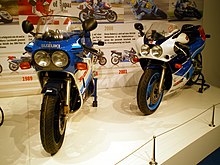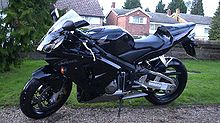Super athlete
A super sports car is a motorcycle built for sporty driving without considering other features such as comfort or payload . In addition to the maximum engine power, the focus is on an optimal ratio of power and vehicle mass as well as the most functional and acceleration-optimized drivability. Technological developments from racing are usually first checked for their suitability for series production on motorcycle models of this class. Suitability for everyday use is of secondary importance for super athletes. First motorcycle of this class which is Suzuki GSX-R 750 called from 1985, the first 750 series engine 100 horsepower (74 kW ) had and an aluminum - double-loop frame as well as for conditions at that time than average performance Nissin brakes equipped.
As early as the 1970s, motorcycles that were powerful for the time were built ( Kawasaki Z900 , Honda CB750 ), but the dimensions of the chassis were usually not sufficiently adapted to the engine power.
State of the art
engine
In terms of engine technology, liquid-cooled, short-stroke inline four-cylinder engines with gasoline injection, two overhead camshafts and four valves per cylinder dominate the market today (2009). Only Ducati , KTM and Buell rely on V2 engines (or L engines with Ducati), Triumph with the Daytona 675 and Benelli with the Tornado , and MV Agusta with the F3, as the only manufacturer on an in-line three-cylinder. Most super sports cars are now built in the 600 cm³ and 1000 cm³ displacement classes , with the latter being called superbike in the meantime based on the FIM regulations .
Chassis / running gear
Torsionally rigid bridge frames made from cast aluminum profiles that integrate the engine as a load-bearing part are the standard today. Lattice frames made from CrMo steel tubes are also occasionally used. The front wheel guidance is provided by adjustable upside-down forks with sliding tubes, often coated to reduce friction , in the spring base, traction and compression damping . The rear suspension is usually carried out using two-arm swing arms made of cast aluminum, single-arm swing arms are rarely installed due to their higher weight. The rear suspension is provided by a single strut with adjustable spring base, tension and compression damping, which is linked either directly or indirectly via a lever system. The wheels today consist exclusively of cast or forged light alloy rims with a diameter of 17 inches and modern radial tires.
Brakes
Standard are floating, perforated double disc brakes made of steel with diameters between 300 and 330 mm. Radially screwed four- or six-piston fixed caliper brake calipers on the front wheels in conjunction with radial hand pumps ensure finely adjustable, high and stable braking decelerations. The brake calipers are more and more made in one piece, which prevents heat-related spreading under high stress. This comparatively new design is called "Monobloc" or "Monoblock". The radial fastening that is common today enables the use of brake disks of different diameters via spacer bushings, which is only relevant when the motorcycle is operated on race tracks.
Model overview
Displacement up to 50 cm³
- Aprilia RS4 50
- MH RX 50R
- Rieju RS3 50
- Yamaha TZR 50
Cubic capacity up to 125 cm³
- Aprilia RS 125
- Aprilia RS4 125
- Cagiva Mito
- Honda CBR125R
- KTM RC 125
- MH RX 125R
- Rieju RS3 125
- Suzuki GSX-R125
- Yamaha YZF-R125
- Cagiva Mito 125
- Sachs XTC 125 2-stroke
- Sachs XTC 125 4-stroke
Cubic capacity up to 150 cm³
Cubic capacity up to 250 cm³
- Hyosung GT 250i R
- Kawasaki 250R
Cubic capacity up to 300 cm³
Cubic capacity up to 350 cm³
Cubic capacity up to 400 cm³
Displacement up to 500 cm³
Displacement up to 600 cm³
- Honda CBR600RR
- Kawasaki Ninja ZX-6R
- Suzuki GSX-R 600
- Triumph Daytona 600
- Yamaha FZR600 (type 3HE)
- Yamaha FZR600R (type 4JH)
- Yamaha YZF-R6
- Yamaha YZF600R Thundercat
Cubic capacity up to 650 cm³
- Hyosung GT 650i R
- Honda CBR 650 F.
- Honda CBR 650 R.
Cubic capacity up to 750 cm³
- Ducati 748
- Ducati 749
- Kawasaki ZX-7R
- MV Agusta F4 750 S.
- Suzuki GSX-R 750
- Triumph Daytona 650
- Triumph Daytona 675
- MV Agusta F3 675
- Yamaha YZF750R
- Yamaha YZF-R7
Displacement up to 1000 cm³
- Aprilia RSV Mille
- Aprilia RSV4
- Benelli Tornado Tre 900
- BMW S 1000 RR
- BMW HP4
- Ducati 848
- Ducati 916/996/998
- Ducati 999
- Ducati Desmosedici RR
- Honda CBR900RR Fireblade (CBR900RR, CBR1000RR)
- Honda SC45
- Kawasaki Ninja ZX-9R
- Kawasaki Ninja ZX-10R
- MV Agusta F4 1000
- MV Agusta F3 800
- Suzuki GSX-R 1000
- Triumph Daytona 765
- Yamaha FZR 1000 (Type 2LA)
- Yamaha YZF-R1
- Kawasaki Ninja H2
Displacement up to 1200 cm³
- BMW HP2 Sport
- BMW R 1100 S.
- BMW R 1200 S.
- Buell 1125R
- Ducati 1098
- Ducati 1198
- Ducati 1199 Panigale
- Kawasaki ZX-12 R
- KTM 1190 RC8
- MV Agusta F4 1078 RR312
Displacement over 1200 cm³
- Kawasaki ZZR 1400
- Suzuki Hayabusa 1300
- Ducati Panigale 1299
Web links
- Andreas Bildl: The technology of the new super athletes - no breathing space. In: MOTORCYCLE . November 22, 2007, accessed January 4, 2014 .
- Andreas Schulz: The best of both worlds. In: MOTORCYCLE. March 27, 2008, accessed January 4, 2014 .
- Stefan Kaschel: What is the point of supersport technology. (No longer available online.) In: MOTORRAD. November 6, 2008, formerly in the original ; accessed on January 4, 2014 . ( Page no longer available , search in web archives )
Individual evidence
- ↑ Stefan Kaschel: 27 years of GSX-R 750. In: MOTORRAD. October 11, 2012, accessed January 13, 2014 .
- ↑ Ducati Motor Holding - www.ducati.com: Ducati Superbike 1299 Panigale - Ducati. In: www.ducati.de. Retrieved June 5, 2016 .

